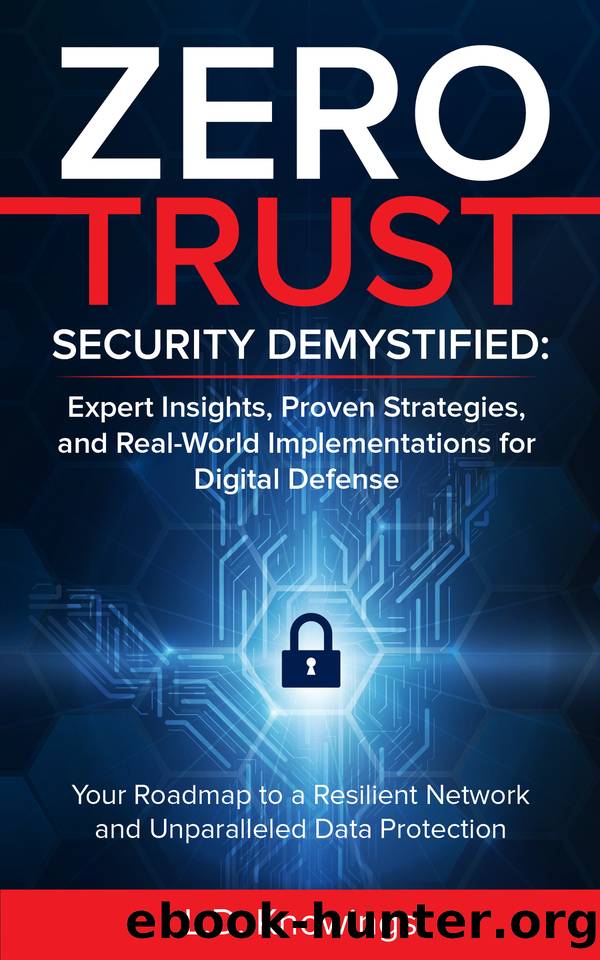ZERO TRUST SECURITY DEMYSTIFIED: Expert Insights, Proven Strategies, and Real World Implementations for Digital Defense: Your Roadmap to a Resilient Network and Unparalleled Data Protection by Knowings L.D

Author:Knowings, L.D.
Language: eng
Format: epub
Published: 2023-11-16T00:00:00+00:00
MONITORING ZERO TRUST
"The only safe computer is the one that's unplugged, locked in a safe, and buried 20 feet under the ground in a secret location... and I'm not even too sure about that one."
ââ âDENNIS HUGES, FBI.
In our age of rampant digital threats, this quote rings true more than ever. But burying computers isn't an option. Instead, we secure them. And Zero Trust is the way to go. Its enforcement, though, relies on real-time visibility into hundreds of user and application identity attributes. These attributes are the eyes and ears of your cybersecurity strategy.
First, consider user identity and credential types. Every user, be it human or programmatic, has a unique identity. Their credentials carry the access keys to your systems. The type of these credentialsâwhether they belong to a person or a softwareâmatters greatly. It's like the ID card at the entrance of a high-security building, defining who gets in and who doesn't.
Next, look at credential privileges on each device. Not all credentials should have the same access. It's like the key card that grants entry to some doors but not others in an office building. Similarly, in your digital landscape, privileges should be tailored per device, per user. This fine-grained access control is a cornerstone of the Zero Trust model.
Thirdly, consider the normal connections for the credential and device, their behavior patterns. Just like knowing the usual paths of a person helps in spotting any unusual activity, understanding the normal patterns of credentials and devices aids in detecting anomalies. It's like a digital footprint that should follow a predictable trail.
Then, there's the endpoint hardware type and function. Knowing what device is connecting to your network and for what purpose is crucial. It's like knowing if a car or a bike is entering your premises and why. An unfamiliar hardware type or an unexpected function could be a red flag.
Your strategy should also account for geo-location. In the same way, you'd be alert if a person from a distant, unexpected location tries to access your building, be aware if a connection request comes from an unusual geo-location. It could be a sign of a potential security threat.
Firmware versions are like the engine versions in vehicles. Some are up-to-date, reliable, and efficient, while others might be outdated and susceptible to breakdowns. Keeping track of these versions helps you ensure your digital engines are robust and secure.
The same applies to operating system versions and patch levels. Just as a patched-up tire might need more attention than a brand new one, devices running on outdated operating systems or patch levels may pose a risk to your network's security. Regular updates and patching are essential in maintaining a strong security posture.
Then, there's the matter of applications installed on the endpoint. It's like knowing what's inside a car before allowing it inside your premises. A dangerous item could pose a risk. Similarly, a malicious application on a device could be a threat to your network.
Lastly, security or incident detections play a critical role. It's
Download
This site does not store any files on its server. We only index and link to content provided by other sites. Please contact the content providers to delete copyright contents if any and email us, we'll remove relevant links or contents immediately.
Sass and Compass in Action by Wynn Netherland Nathan Weizenbaum Chris Eppstein Brandon Mathis(7936)
Grails in Action by Glen Smith Peter Ledbrook(7903)
Configuring Windows Server Hybrid Advanced Services Exam Ref AZ-801 by Chris Gill(7282)
Azure Containers Explained by Wesley Haakman & Richard Hooper(7267)
Running Windows Containers on AWS by Marcio Morales(6813)
Kotlin in Action by Dmitry Jemerov(5311)
Microsoft 365 Identity and Services Exam Guide MS-100 by Aaron Guilmette(5310)
Microsoft Cybersecurity Architect Exam Ref SC-100 by Dwayne Natwick(5039)
Combating Crime on the Dark Web by Nearchos Nearchou(4884)
The Ruby Workshop by Akshat Paul Peter Philips Dániel Szabó and Cheyne Wallace(4580)
Management Strategies for the Cloud Revolution: How Cloud Computing Is Transforming Business and Why You Can't Afford to Be Left Behind by Charles Babcock(4507)
The Age of Surveillance Capitalism by Shoshana Zuboff(4156)
Python for Security and Networking - Third Edition by José Manuel Ortega(4147)
Learn Wireshark by Lisa Bock(3973)
The Ultimate Docker Container Book by Schenker Gabriel N.;(3802)
Learn Windows PowerShell in a Month of Lunches by Don Jones(3581)
DevSecOps in Practice with VMware Tanzu by Parth Pandit & Robert Hardt(3469)
Windows Ransomware Detection and Protection by Marius Sandbu(3462)
Blockchain Basics by Daniel Drescher(3456)
